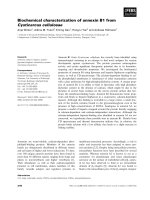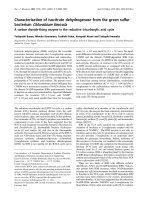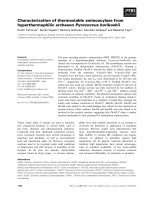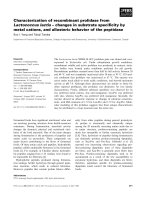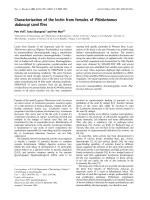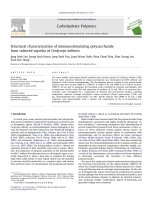Characterization of Tetragenococcus halophilus from Vietnamese fish mash
Bạn đang xem bản rút gọn của tài liệu. Xem và tải ngay bản đầy đủ của tài liệu tại đây (282.42 KB, 7 trang )
Vietnam Journal of Science and Technology 57 (5) (2019) 544-550
doi:10.15625/2525-2518/57/5/13272
CHARACTERIZATION OF TETRAGENOCOCCUS HALOPHILUS
FROM VIETNAMESE FISH MASH
Le Thanh Ha1, Nguyen Nam Trinh1, Le Thi My Chau2, Nguyen Thi Minh Tu1, *
1
School of Biotechnology and Food Technology, Hanoi University of Science and Technology,
1 Dai Co Viet, Hai Ba Trung, Ha Noi
2
School of Chemistry, Biology and Enviroment, Vinh University, 182 Le Duan street,
Vinh city, Nghe An province
*
Email:
Received: 7 November 2018; Accepted for publication: 12 August 2019
Abstract. In this study, the intracellular aminopeptidase activities and volatile’s profiles of
seventeen Tetragenococcus halophilus strains, which were isolated previously from fish mash,
were investigated. Among them, Tetragenococcus halophilus strains CH2-4 and CH6-2
exhibited the highest aminopeptidase activities of 2.1-2.2 U/mL toward Glutamic-pNA, while T.
halophilus strains CH6-1 and V7-2 showed the highest aminopeptidase activities of 1.4-1.5
U/mL toward Leucine-pNA. The fish broth inoculated with T. halophilus strains CH2-4, CH6-2,
CH6-1 and V7-2 for 14 days were treated to obtain the volatiles before being subjected to
GC/MS analysis. A total of 19 volatile compounds, including esters (pentanoic acid, 2ethylhexyl ester; pentanoic acid, 2-propenyl ester), alcohols (3-hexanol; 2-ethyl-1-hexanol; 2furanmethanol), ketones, phenols, hydrocarbons and sulfur containing compounds (sulfurous
acid, butyl 2-ethylhexyl ester and benzyl 2-chloroethyl sulfone) were identified. The groups of
esters and alcohols were the most abundant based on the phenomena that 6 compounds were
identified in each group. T. halophilus CH6-2 strains produced the highest amount of
identified volatile compounds. Among 19 volatile compounds identified, 10 were detected in
sample inoculated with strains CH6-2, while only 5 to 6 volatile compounds were observed in
the samples inoculated with the other strains.
The strains T. halophilus CH6-2 could tolerate NaCl concentration of 25 %. The optimal
condition for its growth was at 5-8 % of NaCl, pH of 6.5 to 7.5 and temperature of less than
37 C.
Keywords: Tetragenococcus halophilus, aminopeptidase activity, fish sauce, volatile compound.
Classification numbers: 1.3.2, 1.4.4.
1. INTRODUCTION
Fish sauce, the popular seasoning in Viet Nam is produced through a natural fermentation
process whereas indigenous microorganisms play an important role. The fish sauce is made by
mixing fish and salt at ratio 3:1, and then the mixture is fermented for more than 12 months. For
shortened fermentation time, improved flavor and aroma of fish sauce, as well as for a better
Characterization of Tetragenococcus halophilus from Vietnamese fish mash
process control, many attempts have focused on using starter cultures like Staphylococcus [1],
Virgribacillus [2], or mixture of Bacillus and Lactobacillus [3], and Tetragenococcus [4].
Tetragenococcus are the most common bacterium in high-salt fermented food products.
This bacterium has been found in various food products, such as Japanese traditional fermented
fish sauce (squid liver sauce) [5], Cambodian fish product [6], and fish nukazuke [7]. The
predominant Tetragenococcus in the final stage of fish sauce fermentation when aroma, colour
and flavor have developed was confirmed by metagenomic method, suggesting their role for
flavor and aroma development [8]. The use of Tetragenococcus halophilus as starter culture for
enzyme hydrolyzed fish protein could reduce the fermentation time to 6 months without
affecting the quality of the fish sauce product [8, 9]. In our previous study, 17 strains of genus
Tetragenococcus halophilus isolated from Cat Hai and Cua Hoi factories were screened [10]. All
the 17 strains were able to use fish protein for their growth, produce oligopeptide by hydrolysis
of fish protein and reduce pH by acid production. In this study, their intracellular
aminopeptidase activities and volatile compound formation were investigated. Furthermore, the
growth characteristics of selected strain with respect to pH, temperature and salt concentration
were also studied.
2. MATERIALS AND METHODS
2.1. Materials
Seventeen Tetragenococcus halophilus strains isolated from Cat Hai and Cua Hoi factories
from previous study [10] were stored at -20 C in glycerol 25 %.
Chemicals for De Man, Rogosa and Sharp (MRS) medium of bacteriological grade were
purchased from LAB (UK) and Merck (Germany). NaCl (China) for media was of analytical
grade. Chemicals for analysis of analytical grade were purchased from Merck (Germany). Fresh
small fish was purchased in Sam Son, Thanh Hoa province, stored in ice and transferred to the
lab.
2.2. Method
2.2.1. Intracellular aminopeptidase activities assay
The studied strains were cultured in MRS broth [11] containing 10 % NaCl then incubated
at 30 °C for 3-5 days under anaerobic condition. Cells were harvested by centrifuging at
10,000×g for 15 min at 4 °C. Afterward, 250 μl of 5 mg/ml lysozyme were added to the cells
and the mixture was incubated at 37 °C for 1 h. Subsequently, the cells were washed twice with
0.2 M phosphate buffer (pH 7.5) and resuspended in 2 ml of the same buffer. The cells were
disrupted using a sonicator for 2 min. Cell debris was removed by centrifugation at 10,000×g for
15 min at 4 °C. The supernatant was used to determine intracellular aminopeptidases activity
using amino p-nitroanilide derivatives Glutamic-pNA and Leucine-pNA [12].
One ml of reaction mixture consisted of 0.1 ml of crude enzyme, 0.1 ml of substrates (GlupNA, Leu-pNA at concentration of 20 mM) and 0.8 ml of 0.2 M phosphate buffer (pH 7.5). The
reaction mixture was incubated at 60 °C for 2 h and then 80 % acetic acid was added to stop the
reaction. The release of p-nitroanilide was measured using a spectrophotometer (PDS 303S,
Apel, Japan) at 405 nm. One unit of enzyme activity (U) was defined as the release of 1 nmole
of p-nitroanilide per minute.
545
Le Thanh Ha, Nguyen Nam Trinh, Le Thi My Chau, Nguyen Thi Minh Tu
2.2.2 Formation of volatile compounds in fish broth
The four selected isolates were cultured on MRS agar containing 10 % NaCl supplemented
with 0.5 % CaCO3 and incubated at 30 °C for 48 h under anaerobic condition. One loopful of
pure culture was inoculated to 50 ml of fish broth containing 25 % NaCl (FB25) and incubated
at 30 °C for 14 days under anaerobic condition. The FB25 was prepared as previously reported
[10]. After 14 days, the supernatant was collected by centrifuging at 10,000×g for 10 min at 4
°C. Volatile compounds were obtained using modified procedure described by Yuan-fan Yang
[13]: distillation followed by extraction with dichloromethane. The GC-MS system used for
analysis was Agilent Technologies 6890N with Agilent 5975 inert XL Mass selective Detector
(Agilent Technologies Co., Ltd., Palo Alto, USA) operating at 70 eV in EI (electron ionization)
mode. Substances were separated on a fused silica capillary column, HP-5MS flexible glass
capillary gas chromatography column (30 m × 0.25 mm × 0.25 μm, Agilent Technologies Co.,
Ltd., Palo Alto, USA).
2.2.3 Growth characteristics of selected T. halophilus
The selected strains were incubated in 10 mL MRS medium for 96 hours at either various pH
from 6 to 8.5 keeping temperature of 35 °C and NaCl concentration of 7 %; or at various
temperature from 25 to 40 °C keeping pH of 7 and NaCl concentration of 7 %; or at various salt
concentration from 0 % to 25 % while keeping temperature of 35 °C and pH of 7. The growth of
the strains was evaluated by OD at 600 nm.
3. RESULTS AND DISCUSSION
3.1. Intracellular aminopeptidase activities
Seventeen T. halophilus strains were cultured and then treated according to 2.2.1. The
aminopeptidase activities were determined, and the results are presented in Figure 1.
Figure 1. Aminopeptidase activities of 17 T. halophilus strains on various substrates.
(Glu = Glutamic- pNA; Leu = Leucine-pNA).
546
Characterization of Tetragenococcus halophilus from Vietnamese fish mash
All strains showed high intracellular aminopeptidase activities towards Glutamic-pNA and
Leucine-pNA. Their aminopeptidase activities towards Glutamic-pNA varied from 1.3 U/mL to
2.2 U/mL, which was higher than those towards Leucine-pNA, which was from 0.3 U/mL to 1.5
U/mL (Figure 1). In this study, T. halophilus strains showed the opposite trend compared to T.
halophilus strains from Thailand fish sauce Nampla, which had higher aminopeptidase activities
towards Leucine than Glutamic acid [14].
The T. halophilus strains CH2-4 and CH6-2 possessed the highest aminopeptidase activity
towards Glutamic-pNA, reaching 2.1-2.2 U/mL, which was as high as the highest one of strain
MCD10-5-10 from Thailand fish sauce Nampla [14]. The strains V7-2 and V6-1 exhibited the
highest aminopeptidase activity towards Leucine-pNA (around 1.3-1.4 U/mL), but still were
about 1.7-fold lower than the highest aminopeptidase activity of MRC5-5-2 from Thailand (2.4
U/mL). Strains with high aminopeptidase activities were preferred since amino acids were
suggested being precursor for volatile compound formation. Leucine is normally converted to
carboxylic acids, such as 2-methylpropanoic acid and 3-methylpropanoic acid, which
contributed to cheesy note [15]. In addition, leucine catabolism activity may result in 3methylbutanal, subsequently, it is converted to 3-methylbutanol and 3-methylbutanoic acid via
reduction and oxidation, respectively [15]. Intracellular aminopeptidase activities towards
glutamic acid could be useful for flavor improvement since glutamic acid contributed to meaty
flavor of fish sauce [16]. Thus, strains CH2-4, CH6-2, CH6-1 and V7-2 were selected for further
volatile compounds analysis.
3.2. Formation of volatile compounds
The four selected strains CH2-4, CH6-2, CH6-1 and V7-2 were cultured and treated as
described in 2.2.2. The volatile composition is presented in Table 1.
A total of 19 volatile compounds have been detected in 4 samples. They could be divided
into groups of esters, alcohols, phenols, ketones, hydrocarbon and sulphur containing
compounds. According to previously reported paper, volatile compounds formed by T.
halophilus are from alcohol, aldehyde, ester and ketone groups [14]. However, in this study no
volatile compounds of aldehyde group were detected. The important role in alcohols formation
in fish broth containing 25 % NaCl by T. halophilus was concluded [14]. Similar phenomenon
was also observed in this study, suggesting that alcohols are the most abundant volatile
compound group which were detected. Among 4 investigated strains, the CH6-2 produced 10
volatile compounds among 19 identified components in total, followed by CH2-4 with 7
components. Strains V7-2 and CH6-1 produced only 5 volatile compounds each. The esters of
pentanoic and butanoic acid, which were found having strong effect on fish sauce aroma [17],
were detected in samples inoculated with CH6-2 and CH2-4 but not with CH6-1 and V7-2.
Interestingly, strains CH6-2 produced three different esters of pentanoic and butanoic acid. The
strain V7-2 produced the most alcohols volatile compounds among four strains, including active
volatile compounds for fish sauce like 2-ethyl-1-hexanol, and 2-furanmethanol. Meanwhile,
CH6-2 formed predominant derivatives of pentanol. Sulfur containing compounds were also
found in samples inoculated with CH6-2 and CH2-4. Based on the volatile profiles, growth
ability in 25% NaCl as well as the oligopeptides formation in a previous study [10], CH6-2 was
selected for further study as starter culture. Further study is needed to evaluate the influence of
volatile compounds on aroma and taste of fish sauce product.
547
Le Thanh Ha, Nguyen Nam Trinh, Le Thi My Chau, Nguyen Thi Minh Tu
ST
T
Table 1. Volatile compounds of fish broth containing 25 % NaCl inoculated with various strains of
T. halophilus.
Volatile compounds
% peak area
KC
Esters
1
Pentanoic acid, 2-ethylhexyl ester
ND
2
Pentanoic acid, 2-propenyl ester
2.65
3
Pentanoic acid, 2,2,4-trimethyl-3hydroxy-, isobutyl ester
ND
4
Butanoic acid, 2,4-dibromo-, ethyl ester
ND
5
2,2-Dimethyl-3-pentanol,
chlorodifluoroacetate
2.17
6
4,4-Dimethyl-2-pentanol,
chlorodifluoroacetate
ND
Alcohols
7
Cyclobutanemethanol, α-methylND
8
Cyclopentanol, 1-methyl3.01
9
3-Hexanol
55.63
10
1-Hexanol, 2-ethylND
11
4-methyl-2,3-pentanediol
ND
12
2-Furanmethanol, tetrahydro-5-methyl-,
transND
Phenols
13
Phenol, 2-(phenylmethoxy)ND
Ketones
14
2-Heptanone, 4,6-dimethyl31.97
15
Ethyl trans-2-pentenoate
0.87
Hydrocarbons
16
Hexane, 1-(3-butenyloxy)ND
Sulfur containing compounds
17
Sulfurous acid, butyl 2-ethylhexyl ester
ND
18
Sulfurous acid, butyl isohexyl ester
ND
19
Benzyl 2-chloroethyl sulfone
ND
“ND“ - Not detected
“KC”- Control sample without inoculating T. halophilus
CH6-1
V7-2
CH6-2
CH2-4
ND
ND
ND
ND
ND
2.39
13.02
ND
ND
ND
ND
ND
2.14
28.48
ND
ND
1.68
2.67
1.61
11.56
ND
ND
21.25
ND
ND
ND
55.82
ND
ND
3.27
ND
ND
2.56
53.17
ND
0.79
0.99
ND
ND
ND
18.36
0.88
ND
ND
ND
2.54
ND
ND
ND
ND
ND
0.76
31.93
ND
ND
ND
ND
ND
0.5
ND
2.57
ND
36.25
ND
ND
ND
1.01
ND
ND
ND
ND
1.61
0.66
0.54
ND
ND
3.3. Growth characteristics of selected strain T. halophilus CH6-2
The effect of pH, salt concentration, temperature and incubation time on growth of strains
CH6-2 was conducted. The growth of the culture was evaluated by optical density at 600 nm.
The result is presented in Figure 2.
The strain CH6-2 grew best at NaCl concentration of 5-8 %, which is similarly reported
earlier for T. halophilus growing well in 5 to 10 % NaCl [18]. In a medium without NaCl, and
at high NaCl concentration of 18 and 25 %, the growth could still be observed but it was very
poorly observed. The OD600 at 25 % NaCl was reduced to 10 times compared to that at 6.5 %.
The optimum pH for the growth of CH6-2 was 7 despite the fact that the growth could be
observed in wide pH range from 6 to 8.5. However, at pH 6 the OD600 was reduced in half.
Similar to results reported by Gurtler [18], in this experiment, the pH optimum for T. halophilus
548
Characterization of Tetragenococcus halophilus from Vietnamese fish mash
was found in a range from 6.5 to 7.5. In this study, T. halophilus CH6-2 could tolerate
temperature of 40 C but 30-35 C was for the best growth.
Figure 2. The influence of NaCl concentration (A), pH medium (B), incubation temperature (C) and
incubation time (D) on the growth of T. halophilus CH6-2 (Cultivation on MRS medium).
4. CONCLUSIONS
Tetragenococcus halophilus in this study exhibited intracellular aminopeptidase activities
towards glutamic acid and leucine. Volatile profiles confirmed the abundant formation of esters
and alcohols by T. halophilus, with the CH6-2 strain forming the most volatile compounds, and
in this study it is the most potential strain as starter culture for fish sauce fermentation. T.
halophilus CH6-2 strain possessed similar growth characteritics to other T. halophilus in terms
of dependence on pH, temperature and NaCl concentration.
Acknowledgment: The authors would like to thank Ministry of Education and Training for providing fund
for project B2017-BKA-37 to pursue this research.
REFERENCES
1.
2.
3.
4.
Udomsil N., Rodtong S., Tanasupawat S., and Yongsawatdigul J. - Improvement of Fish
Sauce Quality by Strain CMC5-3-1: A Novel Species of Staphylococcus sp. Journal of
Food Science 80 (2015) M2015-M2022.
Yongsawatdigul J., Rodtong S., and Raksakulthai N. - Acceleration of Thai Fish Sauce
Fermentation Using Proteinases and Bacterial Starter Cultures. Journal of Food Science
72 (2007) M382-M390.
Nguyễn T. V. A., Bùi T. T. H., Nguyễn Đ. T., and Nguyễn T. H. - Screening of halophilic
lactic acid bacteria and Bacillus for applying to aroma development of fish sauce.
Proceeding of National Conference on Biotechnology 2013 2 (2013) 54-59.
Udomsil N., Rodtong S., Choi Y. J., Hua Y., and Yongsawatdigul J. - Use of
Tetragenococcus halophilus as a Starter Culture for Flavor Improvement in Fish Sauce
Fermentation. Journal of Agricultural and Food Chemistry 59 (2011) 8401-8408.
549
Le Thanh Ha, Nguyen Nam Trinh, Le Thi My Chau, Nguyen Thi Minh Tu
5.
Satomi, M., Kimura, B., Mizoi, M., Sato, T., and Fujii, T. - Tetragenococcus muriaticus
sp. nov., a New Moderately Halophilic Lactic Acid Bacterium Isolated from Fermented
Squid Liver Sauce. International Journal of Systematic and Evolutionary Microbiology
47 (1997) 832-836.
6.
Chuon M. R., Shiomoto M., Koyanagi T., Sasaki T., Michihata T., Chan S., Mao S., and
Enomoto T. - Microbial and chemical properties of Cambodian traditional fermented fish
products, J. Sci. Food. Agric. 94 (2014) 1124-31.
7.
Kuda T., Izawa Y., Ishii S., Takahashi H., Torido Y., and Kimura B. - Suppressive effect
of Tetragenococcus halophilus, isolated from fish-nukazuke, on histamine accumulation
in salted and fermented fish, Food Chemistry 130 (2012) 569-574.
8.
Lee S. H., Jung J. Y., and Jeon C. O. - Bacterial community dynamics and metabolite
changes in myeolchi-aekjeot, a Korean traditional fermented fish sauce, during
fermentation, Int. J. Food. Microbiol. 203 (2015) 15-22.
9.
Udomsil N., Chen S., Rodtong S., and Yongsawatdigul J. - Improvement of fish sauce
quality by combined inoculation of Tetragenococcus halophilus MS33 and Virgibacillus
sp. SK37, Food Control 73 (2017) 930-938.
10. Nga T. T., Tra D. X., and Ha L. T. - Isolation of halophilic lactic bacteria
Tetragenococcus halophilus from Vietnamese fish sauce, Vietnam Journal of Science and
Technology 55 (2017) 186-194.
11. Lee H. M. and Lee Y. - A differential medium for lactic acid-producing bacteria in a
mixed culture. Letters in Applied Microbiology 46 (2008) 676-681.
12. Magboul A. A. A. and McSweeney P. L. H. - Purification and characterization of an
aminopeptidase from Lactobacillus curvatus DPC2024, International Dairy Journal 9
(1999) 107-116.
13. Yang Y. F., Chen S. R., Ni H., and Ye X. Q. - Analysis of volatile components in a
Chinese fish sauce, Fuzhou Yulu, by gas chromatography-mass spectrometry, Journal of
Zhejiang University Science B 9 (2008) 977-981.
14. Udomsil N., Rodtong S., Tanasupawat S., and Yongsawatdigul J. - Proteinase-producing
halophilic lactic acid bacteria isolated from fish sauce fermentation and their ability to
produce volatile compounds, International Journal of Food Microbiology 141 (2010)
186-194.
15. Yvon M. and Rijnen L. - Cheese flavour formation by amino acid catabolism 11 (2001)
185-201.
16. Park J. N., Watanabe T., Endoh K. I., Watanabe K., and Abe H. - Taste-active components
in a Vietnamese fish sauce, Fisheries Science 68 (2002) 913-920.
17. Jiang J., Zeng Q., and Zhu Z. - Analysis of Volatile Compounds in Traditional Chinese
Fish Sauce (Yu Lu), Food Bioprocess Technology 4 (2011) 266-271.
18. Gürtler M., Gänzle M. G., Wolf G., and Hammes W. P. - Physiological Diversity Among
Strains of Tetragenococcus halophilus, Systematic and Applied Microbiology 21 (1998)
107-112.
550
